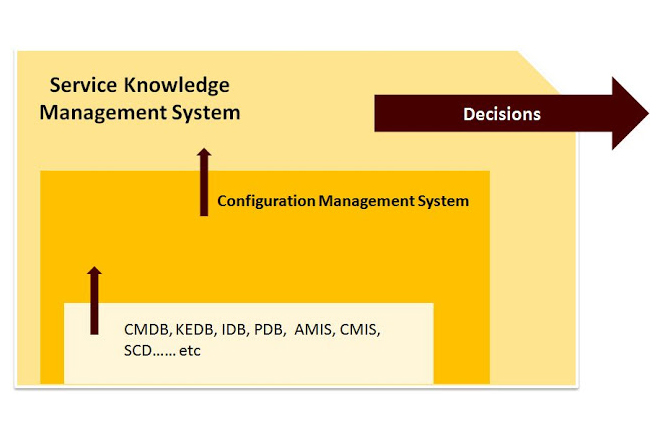2018

Service Transition 2 of 2: The Processes
Of 7 processes underService Transition, 3 are covered in the Foundation Exam Sylllabus. They are Change Management, Service Asset and Configuration Management (SACM), Release and Deployment Management and Knowledge Management
Not covered are:
Transition Planning and Support, Service Validation and the Evaluation Processes.
1) Change Management:
A change is the addition, modification or elimination of an authorized, planned or supporting service (component) and its related documentation,
Change Management is to ensure that standardized methods and procedures exist, to handle changes.that the changes are recorded in the Configuration Management system (CMS) thet the overall business risks are optimized, maximizing value, reducing incidents, disruption and re-work by appropriately responding to the Requests For Changes (RFCs) from the business and IT.
Points to remember:
- Understand the relationship between Change management and Service Asset & Configuration Management.. The “Control” of the Configuration Items are done through Change Management.
- The Change Management covers the changes across the Service Lifecycle including, but not restricted to, the Changes
to Service Portfolio,
to Service Change / Service definition,
by Business Driven Projects,
due to Operational Activities,
- The 3 type of changes are the standard change (Pre-Approved by CAB once, some of which could be implemented by Service Desk with Standard Operating Procedures), the normal change (Approved by “the regular” CAB) and the emergency change (Approved by the eCAB).
- Change Advisory Board (CAB) is an authoritative and representative group of people who are responsible for assessing, from a finance, business and a technical viewpoint, all high impact Requests for Change (RFCs). They advise Change Manager on the priorities of RFCs and propose allocations of resources to implement those Changes. The Change Advisory Board (CAB) will be made up of Customer, User and IT representatives, and may also include, depending upon the nature of the Changes being considered, 3rd party and other administrative business representatives. The CAB is chaired by the Change Manager.
- An Emergency CAB (eCAB), is a Subset of the CAB, that authorizes changes that must be installed faster than the normal process.
- Change Manager is the Chairman of the CABs.
- There may be multiple levels of CABs, in larger Organizations, to manage Strategic and Operational changes.
- All the changes MUST be approved, in one way or the other.
- PIR (Post Implementation review) is a must for ALL changes.
- Evaluating a change would involve the questions, 7Rs.
- The analysis of remedial action plan (which could be a back-out to the prior state) when changes fail, should be a part of the Risk management during the Evaluation process.
- Change to a Business Process is likely to be out-of-scope.
- The defining the Change Management KPIs are the responsibility of the Change Process Owner.
- FSC is the Forward Schedule of Change produced after the approval of the schedules.
- Change Models are for enabling standard procedures to be followed for specific kind of changes.
- Change Authority: is a role, person or a group of people that provides formal authorization foe a particular type of change.
- Understand the relationship between SACM and Change management. The Configuration Items which are to be controlled through the Change Management and are essential to manage the Services are under the SACM process.
- CMDB is the Configuration Management DataBase used to store Configuration Records throughout their Lifecycle. More than one CMDB can exist for an Organization
- The Configuration Management System (CMS) maintains one or more CMDBs, and each CMDB stores Attributes of CIs, and Relationships with other CIs. The CMS also includes information about Incidents, Problems, Known Errors, Changes and Releases; and may contain data about employees, Suppliers, locations, Business Units, Customers and Users. The CMS includes tools for collecting, storing, managing, updating, and presenting data about all Configuration Items and their Relationships. The CMS is maintained by Configuration Management and is used by all IT Service Management Processes.
- Every CI(Configuration Item) record in the CMDB will carry the details of the CI, as varied attributes.
- A Configuration baseline is a configuration of a service, product or infrastructure that has been formally agreed and determined, after which it forms the basis for future activities. This basic configuration can only be changes in accordance with formal change procedures.
- DML (Definitive Media Library) is a secure store where the definitive, authorized,approved, virus free, licensed versions of all software media CIs are stored and monitored. Not the data/backup of data.
- Definitive Spares, similarly, is a secured store for the spare hardware.
-
A Release is acollection of hardware, software, documentation, processes or other components required to implementone or more approved changes to IT services.
-
Release Unit is the collection of the components of an IT service that are normally released together.
- Release Package is a single or collection of structured release units
- The Approaches to release are Phased and Big bang.
- The implementation methods are Automated or Manual
- To release can use technology for a Pull or Push release.
- A release model, like a change model, are for enabling standard procedures to be followed for specific kind of releases. Is likely to contain documented Roles and responsibilities, Template release and deployment schedule, Supporting systems tools and procedures, Handover activities and responsibilities.
The KM is t
- Knowledge management is typically displayed within the Data–Information–Knowledge–Wisdom structure. That will come back in the CSI (Continual Service Improvement) phase.
- Service Knowledge Management System (SKMS) is a set of tools and databases that are used to manage knowledge and information through out the Service Lifecycle.
- Remember this picture:
